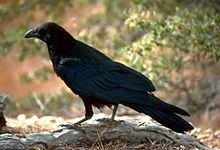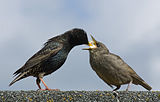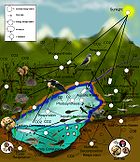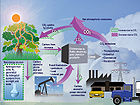- Omnivore
-
 Ravens are omnivores.
Ravens are omnivores.
Omnivores (from Latin: omni all, everything; vorare to devour) are species that eat both plants and animals as their primary food source. They are opportunistic, general feeders not specifically adapted to eat and digest either meat or plant material primarily.
Contents
Definition
Although the term omnivore literally means eater of everything, omnivores cannot really eat "everything" that other animals eat; they can only eat things that are at least moderately easy to get and still at least moderately nutritious. For example, most of them cannot live by grazing (easy to get, but not nutritious enough), nor can they eat some hard-shelled animals or successfully hunt large or fast prey (nutritious, but too hard to get ).
Evolutionary history
Omnivory has evolved several times among different groups of animals. The first vertebrates were piscivores, then insectivores, carnivores and finally herbivores.[1] A complex set of adaptations was necessary for feeding on highly fibrous plant materials, requiring structural modifications to the teeth, jaws, and digestive tract. Only a small proportion of extant tetrapods are obligate herbivores; many carnivores also consume low-fiber plant material as well as insects and fish, so it could be that early tetrapods made the transition to fully fledged herbivory by way of omnivory.[1] There were 2 omnivores at the time of ice age.[citation needed] the hoover mammoth, and the pornesian red bird
Omnivorous species
Although there are cases of Carnivores eating plant matter, as well as examples of herbivores eating meat, the classification refers to the adaptations and main food source of the species in general, so these exceptions do not make either individual animals nor the species as a whole omnivores.
Pigs furnish a well-known example of an omnivore.[2] Crows are another example of an omnivore that many people see every day.[3] As a species, humans are currently divided. While they share virtutally none of the characteristics of most other omnivores or carnivores,[4] such as claws or fangs or short digestive tracts, the majority of humans eat as omnivores, eating both plants and animals for food on a daily basis.[5][6] Many cultures have lived throughout human history as 100% herbivores. A growing percentage of humans today prove to be herbivores, living healthy lives on plants only.
Most bear species are considered omnivores, but individual diets can range from almost exclusively herbivorous to almost exclusively carnivorous, depending on what food sources are available locally and seasonally. Polar bears are classified as carnivores while pandas are classified as herbivores, although giant pandas will eat some meat (e.g., insects) from time to time, and polar bears will sometimes eat plants (such as kelp) but of neither is the exception a significant part of their diet.
Various mammals are omnivorous by nature, such as pigs, badgers, bears, coatis, hedgehogs, opossums, skunks, sloths, squirrels,[7] raccoons, chipmunks,[8] mice[9] and rats.[10] Also some primates are omnivorous including chimpanzees and baboons.[11][12] Various birds are omnivorous, whose diet varies from berries and nectar to insects, worms, fish, and small rodents; examples include cassowarys, chickens, crows and related corvids, keas, rallidae, and rheas. In addition, some lizards, turtles, fish, such as piranhas, and invertebrates are also omnivorous.
While virtually all mammals may display "omnivorous" behavior patterns—depending on conditions of supply, culture, etc.—mammals will generally prefer one class of food or another, with optimized digestive processes. Like most arboreal species, most squirrels are primarily granivores, preferring nuts and seeds.[13] but as with virtually all mammals, squirrels can resort to consuming some meat as fallback food if starving or facultatively, e.g., when nests are in danger of being raided by predators, etc.
Depending on the species of bear, there is generally a preference for one class of food or another as plants and animals are digested differently.
While scientific classification aims to promote communication and analysis of various differences and similarities between species, the concept of an "omnivore" is broad and could be applied to virtually any mammal since disease risks and the quality of digestion are often not considered. There are social, psychological and non-nutritive factors that influence diet behavior. "[T]he behavioral basis of omnivory has not been thoroughly explored... and food selection behavior is central to understanding the causes and consequences of omnivory. However, few studies have actually addressed this issue through rigorous tests of multiple hypotheses."
In order for the concept of "omnivore" to be regarded as a scientific classification, some clear set of measurable and relevant criteria would need to be considered to differentiate between an "omnivore" and the other vague but less ambiguous diet categories e.g., faunivore, folivore, scavenger, etc.[14]
References
- ^ a b Sahney, S., Benton, M.J. & Falcon-Lang, H.J. (2010). "Rainforest collapse triggered Pennsylvanian tetrapod diversification in Euramerica" (PDF). Geology 38 (12): 1079–1082. doi:10.1130/G31182.1. http://geology.geoscienceworld.org/cgi/content/abstract/38/12/1079.
- ^ Brent Huffman. "Family Suidae (Pigs)". UltimateUngulate.com. http://www.ultimateungulate.com/Cetartiodactyla/Suidae.html. Retrieved 2007-12-29.
- ^ Seattle Audubon Society. "Family Corvidae (Crows/Ravens)". BirdWeb.org. http://birdweb.org/birdweb/bird_details.aspx?id=318. Retrieved 2011-01-01.
- ^ John Coleman. "Comparative Anatomy, Taxonomy". tierversuchsgegner.org. http://www.tierversuchsgegner.org/wiki/index.php?title=Taxonomy. Retrieved 2007-12-31.
- ^ Adapted from a talk by John McArdle, Ph.D. "Humans are Omnivores". Vegetarian Resource Group. http://www.vrg.org/nutshell/omni.htm. Retrieved 2007-12-29.
- ^ "Omnivores". NatureWorks, New Hampshire Public Television. http://www.nhptv.org/natureworks/nwep10b.htm. Retrieved 2009-09-09.
- ^ "Tree Squirrels". The Humane Society of the United States. http://www.hsus.org/wildlife/a_closer_look_at_wildlife/tree_squirrels.html. Retrieved 2009-01-01.
- ^ "Eastern Chipmunk". Wonder Club. http://www.wonderclub.com/Wildlife/mammals/easternchipmunk.htm. Retrieved 2009-01-01.
- ^ "Florida Mouse". United States Fauna. http://www.unitedstatesfauna.com/floridamouse.php. Retrieved 2009-01-01.
- ^ "Brown Rat". Science Daily. http://www.sciencedaily.com/articles/b/brown_rat.htm. Retrieved 2009-01-01.
- ^ "Chimps on the Hunt". BBC. http://www.bbc.co.uk/nature/species/Common_Chimpanzee#p004hd8g. Retrieved 2010-03-23.
- ^ "Savanna Chimpanzees, Pan troglodytes verus, Hunt with Tools". Science Direct. http://www.sciencedirect.com/science?_ob=ArticleURL&_udi=B6VRT-4N3XDTT-1&_user=10&_coverDate=03/06/2007&_rdoc=1&_fmt=high&_orig=search&_sort=d&_docanchor=&view=c&_acct=C000050221&_version=1&_urlVersion=0&_userid=10&md5=286aed913a0bc2720bb09d6333f8ebbc. Retrieved 2010-03-23.
- ^ Halle, S. & Stenseth, N. (2000). Activity patterns in small mammals: an ecological approach. Berlin; Heidelberg, Germany; New York: Springer-Verlag.
- ^ Singer, Michael S.; Bernays, Elizabeth A. (2003). "Understanding Omnivory Needs: A Behavioral Perspective". Ecology 84 (10): 2532–2537. doi:10.1890/02-0397.
Feeding behaviours Carnivores adultHematophagy · Insectivore · Lepidophagy · Man-eater · Molluscivore · Mucophagy · Myrmecophagy · Ophiophagy · Piscivore · Avivore · Spongivore · Vermivore · Herpetivorereproductivecannibalistic
Herbivores Others Methods Apex predator · Bait balls · Bottom feeding · Browsing · Feeding frenzy · Filter feeding · Grazing · Hypercarnivore • Intraguild predation · Kleptoparasitism · Scavenging · TrophallaxisPredation · Antipredator adaptation · Carnivorous plant · Carnivorous fungus · Carnivorous protist · Category:Eating behaviorsCategories:- Eating behaviors
Wikimedia Foundation. 2010.



